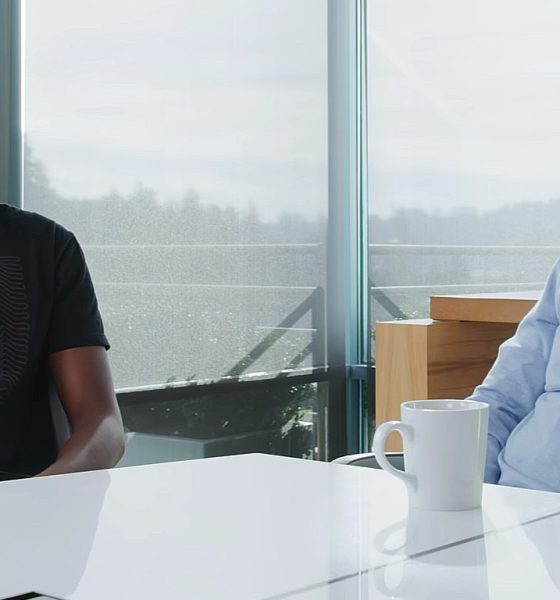

News
Bill Gates shares insights on Tesla and all-electric trucks in MKBHD interview
In a recent, brief interview with YouTube tech reviewer Marques Brownlee, billionaire-philanthropist Bill Gates talked about his views on electric vehicles such as Tesla, as well as his thoughts on emissions from the transportation sector. In the short conversation, the Microsoft co-founder praised Tesla’s electric cars, though he also admitted that there is still a lot that needs to be done to make transportation significantly cleaner.
Bill Gates is no stranger to Tesla’s vehicles. Back in 2016, the tech titan was filmed driving casually in a Tesla Model X with Seveneves author Neal Stephenson. Referring to the Silicon Valley-based electric car maker in his recent interview; Gates pointed out that Tesla’s vehicles are “amazing,” while stating that the company still has a long road ahead. The Microsoft co-founder also noted that car buyers would soon have more electric vehicles to choose from.
“Tesla is an amazing product that’s catching on, but it’s still a pretty small percentage of the market. It’s a premium price vehicle, and they lost their $7,500 tax credit, so it’s making it tougher. Now, a ton of other manufacturers are gonna come in, partly because the California zero emissions and partly because people see these trends. There will be a lot of great electric cars to choose from,” Gates said.
Unfortunately, Bill Gates still appeared to be quite cautious with the idea of batteries being used for the long-haul market. The billionaire-philanthropist further added that electric cars would not be fully emissions-free until the grid becomes completely independent of fossil fuels.
“(For) passenger cars — the power output you need is lower than for a truck. So eventually, batteries might work for a truck, but it’s a far more difficult problem because the weight is a lot higher there. Even those passenger cars, one thing to be careful of is unless the electric has gotten to zero, the electric car is still an emitter because of the indirect emissions from the electricity it uses. And so, only in the places where you both get the electric cars to a high percentage and you get the electric sources to be zero emissions, then you’ve got that passenger transport car piece near to zero,” Gates said.
While the Microsoft co-founder has a valid point regarding his concerns about electric vehicles, it should be noted that EVs are cleaner than fossil fuel-powered cars even if the electricity used to charge them comes mainly from coal. This point was highlighted in a recent study from Bloomberg NEF, which concluded that carbon dioxide emissions from battery-powered vehicles are 40% lower than those from cars equipped with internal combustion engines, even in areas that are reliant on coal such as China.
The billionaire-philanthropist also appears to be discounting the progress in battery technology that have been accomplished by companies such as Tesla. Over the past year, Elon Musk hinted that Tesla is already closing in on the $100 per kWh mark, which would help the company’s electric cars achieve price parity with gas-powered vehicles. Battery tech has also progressed to a point where the Tesla Semi, an upcoming all-electric long-hauler, has been noted to feature closer to 600 miles per charge. So compelling are the improvements in batteries that even companies such as Nikola Motor, which has sworn by hydrogen-electric tech, have decided to release battery-powered variants of its upcoming trucks.
Based on Bill Gates’ statements in his interview with Marques Brownlee, it appears that it would still take some time before he fully warms up to the idea of battery-powered vehicles serving as potential catalysts for the world’s transition towards sustainable energy. Considering Tesla’s progress over the years, it might only be a matter of time before the Microsoft co-founder fully embraces electric cars.
Watch MKBHD’s interview with Bill Gates in the video below.

News
Tesla FSD fleet is nearing 7 billion total miles, including 2.5 billion city miles
As can be seen on Tesla’s official FSD webpage, vehicles equipped with the system have now navigated over 6.99 billion miles.

Tesla’s Full Self-Driving (Supervised) fleet is closing in on almost 7 billion total miles driven, as per data posted by the company on its official FSD webpage.
These figures hint at the massive scale of data fueling Tesla’s rapid FSD improvements, which have been quite notable as of late.
FSD mileage milestones
As can be seen on Tesla’s official FSD webpage, vehicles equipped with the system have now navigated over 6.99 billion miles. Tesla owner and avid FSD tester Whole Mars Catalog also shared a screenshot indicating that from the nearly 7 billion miles traveled by the FSD fleet, more than 2.5 billion miles were driven inside cities.
City miles are particularly valuable for complex urban scenarios like unprotected turns, pedestrian interactions, and traffic lights. This is also the difference-maker for FSD, as only complex solutions, such as Waymo’s self-driving taxis, operate similarly on inner-city streets. And even then, incidents such as the San Francisco blackouts have proven challenging for sensor-rich vehicles like Waymos.
Tesla’s data edge
Tesla has a number of advantages in the autonomous vehicle sector, one of which is the size of its fleet and the number of vehicles training FSD on real-world roads. Tesla’s nearly 7 billion FSD miles then allow the company to roll out updates that make its vehicles behave like they are being driven by experienced drivers, even if they are operating on their own.
So notable are Tesla’s improvements to FSD that NVIDIA Director of Robotics Jim Fan, after experiencing FSD v14, noted that the system is the first AI that passes what he described as a “Physical Turing Test.”
“Despite knowing exactly how robot learning works, I still find it magical watching the steering wheel turn by itself. First it feels surreal, next it becomes routine. Then, like the smartphone, taking it away actively hurts. This is how humanity gets rewired and glued to god-like technologies,” Fan wrote in a post on X.
News
Tesla starts showing how FSD will change lives in Europe
Local officials tested the system on narrow country roads and were impressed by FSD’s smooth, human-like driving, with some calling the service a game-changer for everyday life in areas that are far from urban centers.

Tesla has launched Europe’s first public shuttle service using Full Self-Driving (Supervised) in the rural Eifelkreis Bitburg-Prüm region of Germany, demonstrating how the technology can restore independence and mobility for people who struggle with limited transport options.
Local officials tested the system on narrow country roads and were impressed by FSD’s smooth, human-like driving, with some calling the service a game-changer for everyday life in areas that are far from urban centers.
Officials see real impact on rural residents
Arzfeld Mayor Johannes Kuhl and District Administrator Andreas Kruppert personally tested the Tesla shuttle service. This allowed them to see just how well FSD navigated winding lanes and rural roads confidently. Kruppert said, “Autonomous driving sounds like science fiction to many, but we simply see here that it works totally well in rural regions too.” Kuhl, for his part, also noted that FSD “feels like a very experienced driver.”
The pilot complements the area’s “Citizen Bus” program, which provides on-demand rides for elderly residents who can no longer drive themselves. Tesla Europe shared a video of a demonstration of the service, highlighting how FSD gives people their freedom back, even in places where public transport is not as prevalent.
What the Ministry for Economic Affairs and Transport says
Rhineland-Palatinate’s Minister Daniela Schmitt supported the project, praising the collaboration that made this “first of its kind in Europe” possible. As per the ministry, the rural rollout for the service shows FSD’s potential beyond major cities, and it delivers tangible benefits like grocery runs, doctor visits, and social connections for isolated residents.
“Reliable and flexible mobility is especially vital in rural areas. With the launch of a shuttle service using self-driving vehicles (FSD supervised) by Tesla in the Eifelkreis Bitburg-Prüm, an innovative pilot project is now getting underway that complements local community bus services. It is the first project of its kind in Europe.
“The result is a real gain for rural mobility: greater accessibility, more flexibility and tangible benefits for everyday life. A strong signal for innovation, cooperation and future-oriented mobility beyond urban centers,” the ministry wrote in a LinkedIn post.
News
Tesla China quietly posts Robotaxi-related job listing
Tesla China is currently seeking a Low Voltage Electrical Engineer to work on circuit board design for the company’s autonomous vehicles.

Tesla has posted a new job listing in Shanghai explicitly tied to its Robotaxi program, fueling speculation that the company is preparing to launch its dedicated autonomous ride-hailing service in China.
As noted in the listing, Tesla China is currently seeking a Low Voltage Electrical Engineer to work on circuit board design for the company’s autonomous vehicles.
Robotaxi-specific role
The listing, which was shared on social media platform X by industry watcher @tslaming, suggested that Tesla China is looking to fill the role urgently. The job listing itself specifically mentions that the person hired for the role will be working on the Low Voltage Hardware team, which would design the circuit boards that would serve as the nervous system of the Robotaxi.
Key tasks for the role, as indicated in the job listing, include collaboration with PCB layout, firmware, mechanical, program management, and validation teams, among other responsibilities. The role is based in Shanghai.
China Robotaxi launch
China represents a massive potential market for robotaxis, with its dense urban centers and supportive policies in select cities. Tesla has limited permission to roll out FSD in the country, though despite this, its vehicles have been hailed as among the best in the market when it comes to autonomous features. So far, at least, it appears that China supports Tesla’s FSD and Robotaxi rollout.
This was hinted at in November, when Tesla brought the Cybercab to the 8th China International Import Expo (CIIE) in Shanghai, marking the first time that the autonomous two-seater was brought to the Asia-Pacific region. The vehicle, despite not having a release date in China, received a significant amount of interest among the event’s attendees.








